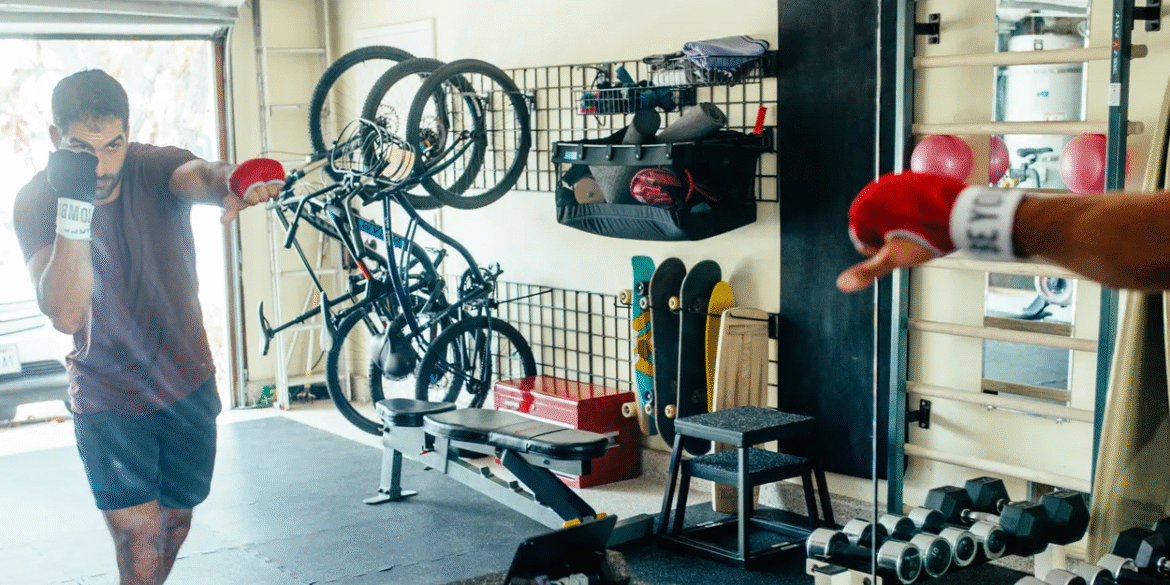Boxing is a powerful sport that builds strength, speed, and confidence. Whether you’re training for fitness, self-defense, or just want a fun way to stay active, boxing is a great choice. But going to a boxing gym can be expensive, crowded, or inconvenient. The good news is that you can create your own boxing gym right in your garage. You don’t need a lot of space or money—just smart planning and some basic equipment.
In this article, we’ll walk you through how to turn your garage into a mini home gym for boxing. We’ll cover everything from cleaning the space to picking the right gear and creating your workout routine.
Step 1: Clear and Clean Your Garage
The first step is to make room for your gym. If your garage is full of boxes, tools, or old furniture, start by removing anything you don’t need. Try to free up an open area of at least 6 by 6 feet. That’s enough space for one person to train safely.
Once you’ve cleared the space, clean the floor. Sweep away dust, dirt, or leaves. If your garage floor is smooth concrete, you might want to add mats or rubber flooring to avoid slipping while you train. A clean, safe surface is important for boxing footwork and movement.
Step 2: Choose the Right Flooring
Boxing involves quick movements, pivoting, and bouncing on your feet. Hard or slippery floors can be dangerous. For your safety and comfort, add soft flooring to your garage gym.
Here are some simple options:
- Foam puzzle mats: These are soft, easy to install, and help absorb impact
- Rubber gym mats: These are great for heavy use and protect your floor
- Old carpet or rugs: A budget-friendly option if you don’t want to buy new mats
Whichever you choose, make sure it stays in place and gives you a good grip.
Step 3: Buy Basic Boxing Equipment
You don’t need fancy machines or a lot of gear to train like a boxer. Just a few key items can give you a great workout.
The most important item is a heavy bag. This is the large bag you punch. You can hang it from a ceiling beam or buy a standing version that sits on the floor. If you’re hanging it, make sure the ceiling is strong enough to hold the weight.
Next, get a good pair of boxing gloves. Gloves protect your hands and wrists while punching the bag. Most beginners use 12- or 14-ounce gloves. You’ll also need hand wraps. These are long cloth wraps that go under your gloves and keep your wrists supported.
You should also have a jump rope. It’s one of the best warm-up tools for boxing. Jumping rope builds stamina, coordination, and speed.
If you want to practice your skills further, consider a mirror. A full-length mirror lets you see your punches and footwork. It helps you improve your form while shadowboxing.
Some optional items include a speed bag (for quick punches), a double-end bag (for timing and accuracy), and a timer or boxing app to keep track of your rounds.
Step 4: Add Strength and Conditioning Tools
Boxing is more than just punching. Boxers also need strength, balance, and good cardio. You can add a few tools to help with these parts of training.
Here are a few items that don’t take much space:
- Resistance bands: Great for shoulder warm-ups and strength
- Dumbbells or kettlebells: Use light weights for shadowboxing or heavier weights for muscle training
- Pull-up bar: Builds upper body and grip strength
- Medicine ball: Good for explosive movements and core work
- Yoga mat: For stretching, push-ups, and ab exercises
You don’t need to buy everything at once. Start small, then add more as you grow.
Step 5: Set Up Your Space
Now that you have your equipment, organize your gym so everything is easy to use. Hang your heavy bag in a safe area where it can swing without hitting anything. Keep gloves, wraps, and jump ropes in a basket or on wall hooks. If you use weights or bands, store them neatly to avoid tripping.
If you want to listen to music or follow online workouts, add a Bluetooth speaker or tablet stand. You can also add posters or quotes to keep you motivated.
Make sure there’s good lighting so you can see clearly. If your garage has windows, that’s great for fresh air and natural light. If not, add a fan for air circulation and LED lights for brightness.
Step 6: Safety Comes First
Even at home, you should train safely. Always warm up before you start, and stretch after your workout. Use hand wraps and gloves when hitting the bag to avoid injury. If you’re trying new moves or lifting weights, take your time and learn the proper form.
Keep your space clean. Wipe down gear after use. Make sure the floor is dry and free of clutter. If something breaks or doesn’t feel right, stop and fix it.
Also, don’t forget to stay hydrated. Keep a water bottle close during workouts.
Step 7: Create a Simple Training Routine
Now it’s time to use your new boxing gym. A good training session can be as short as 30 minutes. Here’s a basic routine you can follow:
Warm-up (5 minutes)
- Jump rope
- Arm circles
- Light shadowboxing
Boxing Drills (15 minutes)
- Shadowboxing (2 rounds)
- Heavy bag work (3 rounds)
- Focus on different combos and footwork each round
Strength and Conditioning (5–10 minutes)
- Push-ups
- Squats
- Sit-ups or planks
- Dumbbell curls or shoulder presses
Cool Down (5 minutes)
- Stretch your legs, arms, and back
- Slow breathing to relax your body
You can use a boxing timer app to set your rounds (usually 2 or 3 minutes of work and 30 seconds of rest).
As you get stronger and better, add more rounds or try advanced workouts. You can also follow online classes or YouTube boxing trainers.
Step 8: Stay Motivated and Track Your Progress
One great thing about a home gym is that it’s always open. But that also means it’s easy to skip workouts. To stay on track, set simple goals. Write them down in a notebook or on your phone. For example, you might aim to train three days a week, or to learn a new punch each week.
Tracking your progress helps you stay motivated. You’ll see how far you’ve come and what you still want to achieve. Take videos or notes of your workouts to see your improvements.
You can also change things up by adding new drills, listening to different music, or trying fun boxing challenges.
Final Thoughts
Turning your garage into a boxing gym doesn’t have to be hard or expensive. With just a few pieces of gear and some creative setup, you can build a space where you can train anytime, stay fit, and have fun. It’s your own private gym—no membership fees, no waiting for machines, no pressure from others.
Whether you’re a beginner or already experienced, a garage boxing gym gives you the freedom to work at your own pace and grow stronger every day. Just remember to train smart, stay safe, and enjoy the process.
Your boxing journey starts with one punch—and your garage is the perfect place to throw it.



